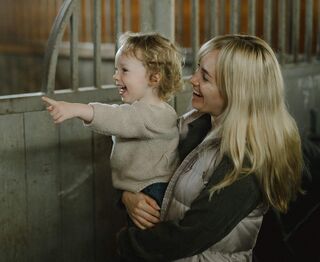Laughter
The Laughter of Toddlers
Our sense of humor takes a giant stride forward just as we do.
Posted November 15, 2022 Reviewed by Michelle Quirk
Key points
- What we find amusing, and to what degree, differs between individuals but also changes over the course of our own lives.
- Laughter requires an understanding of goals and limitations, so we’d expect the range of things that amuse would increase over time.
- As we transition from infant to toddler, cognitive developments help us to better distinguish vulnerabilities from the normal or deficient.
Scholars interested in laughter have long wondered why people differ in what they find amusing, not only compared to others but also over time as they grow from infant to adult. Having discussed the laughter of infancy in my previous post, here I submit some personal observations about how a toddler’s sense of humor blossoms in every possible way.
The Expanding Breadth of a Toddler’s Laugh Response
Between the ages of 1 and 3 years, children accelerate their development of life skills beneath the protective eye of close family and caregivers. Physically, they are completing the transition from creeping and crawling to walking, running, and climbing, and becoming increasingly adept at manipulating objects with their hands. This, of course, is not an overnight process. Toddlers will stumble and fall while attempting to walk and fail to grasp a toy in the precise way needed. As they progress, young children develop new standards for the kinds of setbacks that constitute expressions of physical vulnerability in the areas of coordination, strength, and agility.
- Physically and emotionally: Toddlers are also evolving emotionally. Increasing independence means a greater appreciation for—and control over—emotional drives. They become more aware of the types and intensities of emotions that will best serve them in particular circumstances and, as a result, become more conscious of deviations. They can be scared into a bout of laughter if their initial fear is subsequently deemed unwarranted (for example, a startled reaction to a caretaker’s playful attack). And they can be excited into laughter when their reaction seems greater than a situation might have called for (perhaps the initial scream of delight in getting a puppy on their birthday). Playful chases, in which laughter seems to thrive, are a mixture of tempered fear responses and barely controlled excitement.

- Cognitively: Greater mobility and exploratory play invariably result in an increasing familiarity with the physical components of one’s environment and the principles that govern them—gravity, friction, the effects of shape, inertia, mass, hardness, odor, tonal qualities, immutability, and so on. Children acquire more experience distinguishing “normal” from “abnormal” by assessing their own behavior and abilities, those of others, and those of various components of their physical world. There is an explosion of cognitive development. As they discover the world, they experience the same sort of wonder and awe—and amusement—as does the adult standing before a skilled magician.
- Socially: Besides their physical environment, toddlers are also expanding the boundaries of their social world. Most notably, they’re developing greater sophistication for using nonverbal communications, adding these to the rapid advancement of verbal language. They now pick up on the nuance of facial expressions conveying subtle emotions, including those that cue for humor—the eyebrow flash, the wry smile, the obviously deceptive glance, the exaggerated look of embarrassment or frustration. Words, along with intonations and other qualities that convey emotion and intent, provoke a greater degree of empathy and consideration.
Whereas "self-lifting laughter" predominated in the infant stage, now "lifting laughter" takes firm root. Toddlers better understand others’ vulnerability as if it were their own. They’re becoming more sympathetic such that others’ failings are increasingly sources of amusement. At this stage, however, their expectations are not always age-adjusted. Toddlers may perceive adults as having the same kinds and levels of vulnerability as children. An adult at the top of a slide, for example, might be assumed as having the same mild anxieties as would a child in that situation, and the toddler would respond accordingly with lifting laughter.
Anticipation
Another skill being developed at this stage is anticipation. Anticipation is the ability to project potential outcomes from past actions, and it plays a large part in how we perceive vulnerability. (Remember that what ultimately defines vulnerability is its likely consequence to physical survival and reproduction. We project the potential loss of status that results from a social faux pas, the potential hindrance caused by an irrational phobia, or the potential consequences of miscommunication or deception).
Infants have this ability in a limited way—given the right cues they will laugh in anticipation of a tickling “attack.” However, it’s seen in the toddler to a much greater degree and exercised over a wider range of vulnerability types (including cognitive and social). Toddlers will anticipate that tumble at the bottom of the slide, the startle response at finding someone hiding in the closet, and the consequences of an attempted ruse. Anticipatory laughter is, in effect, the preemptive communication of a desire for parity, an early endorsement of the status quo. Indeed, even as adults, much of our laughter is of this sort.
Anthropomorphism
The last related skill mastered by the toddler is that of anthropomorphism. This is the projection of human traits and motivations onto nonhuman animals and objects. As with anticipation, anthropomorphism is observed during the first year of life (likely another of our innate behavioral attributes) but sees its full expression during the toddler phase. This means laughter may be solicited by the actions of anything understood to possess, if only in one’s imagination, human attributes. Thus, the toddler will laugh at the dog in a birthday hat, the puppet that dances and pirouettes, or the tire that wobbles, swerves, and bounces down a hillside. Objects can be endowed with physical, emotional, cognitive, and social vulnerabilities—a tendency that carries right through to adulthood.
Enjoy this YouTube video: Young toddler plays a trick on daddy.
This post draws from Chapter Five of my book, Why We Laugh: A New Understanding.
© John Charles Simon
References
Simon, J. C. (2008) Why We Laugh: A New Understanding. Starbrook Publishing.


